Testing and improving spectral energy distribution (SED) modeling codes
SED modeling is a technique that is used to infer physical properties from galaxy photometry. It works by treating a galaxy as a sum of its parts: single-age stellar population (SSP) SED templates are summed, with the weight each SSP SED set by the assumed star formation history (SFH). Emission from an active galactic nucleus (AGN) may also be included. A dust attenuation curve is used to approximate the effects of dust absorption and scattering; often, it is assumed that the young (<~10-Myr-old) stars are more attenuated than older stars because they are still embedded in their molecular 'birth clouds’. Some SED modeling codes also include simple models for dust emission (typically sums of modified blackbodies). By varying the (many) input parameters, one can generate a large library of SED templates, or the templates can be computed on-the-fly during the fitting process. Then, given a galaxy’s SED, one can determine maximum-likelihood estimates for properties of the galaxy, such as the star formation rate (SFR) and stellar mass. Some commonly used SED modeling codes include MAGPHYS and CIGALE.
To make the SED modeling problem tractable, many approximations are made. For example, the SFH is usually assumed to have a simple form (e.g. an exponential SFR with superimposed bursts). It is of crucial importance to know whether any of the approximations about e.g. the SFH and dust attenuation prevent us from accurately recovering the physical parameters of galaxies, especially because much of our knowledge regarding high-redshift galaxies depends on this technique. Unfortunately, it is very difficult to test the SED modeling technique using observations because independent estimates of quantities such as the SFR are generally not available. However, there is a solution: we can use SEDs predicted from simulated galaxies, for which the physical properties are known by construction, to test some of the assumptions that underlie the SED modeling approach. Simulated galaxies have SFHs and dust geometries that are considerably more complicated than those assumed in the SED modeling (albeit still simpler than those of real galaxies), and the influence of factors such as AGN emission and dust composition can be directly explored.
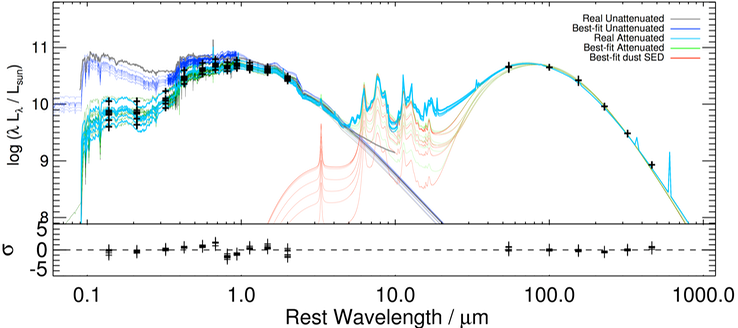
In Hayward & Smith (2015), we applied the SED modeling code MAGPHYS to simulated galaxy SEDs that we generated by performing dust radiative transfer on the outputs of hydrodynamical simulations of an isolated galaxy and a galaxy merger. The cyan lines in the above figure are the SEDs corresponding to a single time snapshot of a simulated galaxy merger viewed from seven different viewing angles. The unattenuated SED, which is independent of viewing angle, is shown in gray. For the simulated SEDs, we computed photometry in various bands (black plus signs) and used MAGPHYS to fit the photometry; the best-fitting SEDs are shown by the green lines, and the corresponding unattenuated SEDs are the blue lines. The simulated photometry can clearly be fit well. However, it is worth noting that the unattenuated SED is not accurately recovered, and MAGPHYS incorrectly infers different unattenuated SEDs for each of the viewing angles.
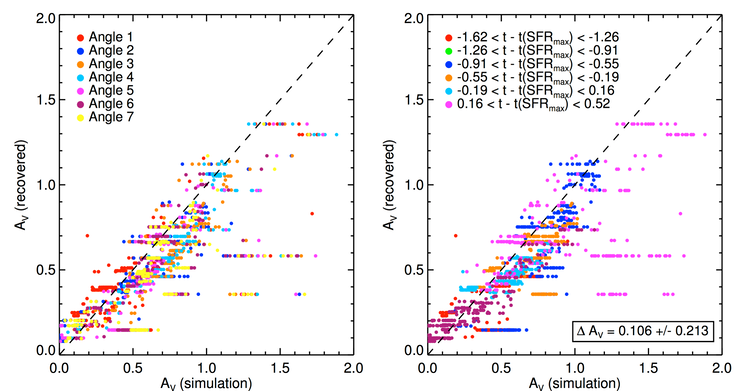
Except for near the peak of the merger-induced starburst, MAGPHYS yielded statisfactory fits to the simulated photometry. Thus, we proceeded to investigate how well the physical parameters were recovered. We found that despite the simplifying assumptions employed in MAGPHYS (and other SED modeling codes), the physical parameters of the simulated galaxies, such as the SFR and stellar mass, were recovered surprisingly well. The above figure shows the results for one parameter, the V-band attenuation (in magnitudes). The left panel shows the recovered value versus the true value with the points colored according to viewing angle, whereas in the right panel, the points are colored according to the time since the starburst. We see that the attenuation is generally well recovered, except for the time right after the starburst (magenta points in the right panel), when the attenuation is underestimated by MAGPHYS.
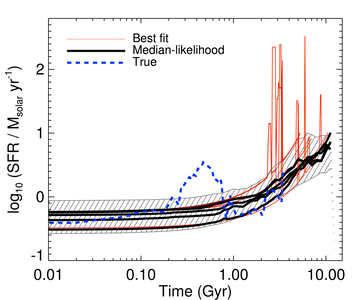
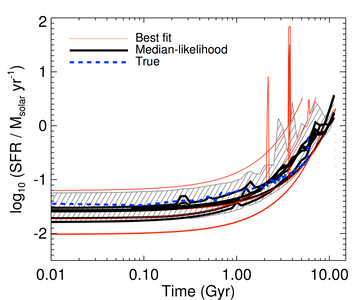
In Smith & Hayward (2015), we presented modifications to the MAGPHYS code that enable one to derive maximum-likelihood estimates for the full SFH of a galaxy, not only its current SFR. We then tested how well the modified code could recover the SFHs of our simulated galaxies. The above plots show the results of fitting the SEDs of a simulated isolated disk galaxy (left) and major merger (right) viewed from seven viewing angles at a single time. In each panel, the dashed blue line corresponds to the true SFH. The thick solid black lines show the median-likelihood SFHs inferred from fitting the SEDs (one per viewing angle), and the shaded area represents the one-sigma uncertainty on the SFH. The red lines denote the SFHs of the best-fitting SEDs (again, one per viewing angle). In both cases, the median-likelihood SFHs are clearly superior to those of the best-fitting SEDs, which tend to exhibit spurious bursts and can be significantly offset from the true SFH. For the isolated disk, the median-likelihood estimates of the SFH are in excellent agreement with the true SFH. For the merger, neither the SFHs corresponding to the best-fitting SEDs nor the median-likelihood SFHs accurately recover the true SFH. This suggests that the prior on the SFH (i.e. the SFH form assumed when generating the MAGPHYS SED template library) is too restrictive, and it is necessary to use more complicated SFHs (e.g. SFHs drawn from simulations) if one wishes to accurately recover the SFHs of galaxies via SED modeling.
Fitting far-infrared SEDs with modified blackbodies
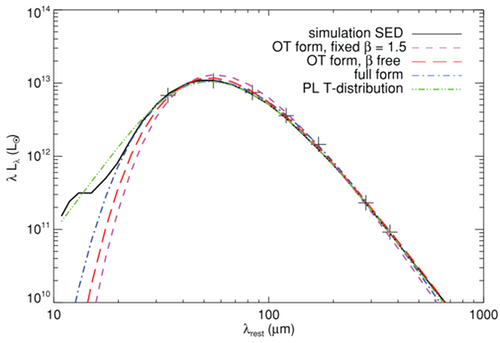
In Hayward et al. (2012), we compared different forms for fitting far-IR galaxy SEDs, including the optically thin single-temperature modified blackbody (the most commonly used form), the full form of the single-temperature modified blackbody, and a model that has a power-law distribution of dust temperatures. The above figure shows the different forms fit to the far-IR photometry of a simulated SMG. In general, the effective dust temperatures and power-law index for the far-IR emissivity, beta, vary depending on the form used, and no form recovers the intrinsic beta assumed in the radiative transfer calculations. Thus, whereas fitting modified blackbodies can be useful for comparing SEDs using only a few parameters (i.e. they provide a simple form that can often encapsulate the data), one should use caution when attempting to interpret the parameters physically.